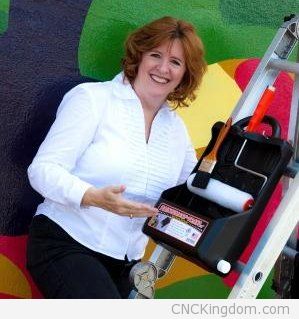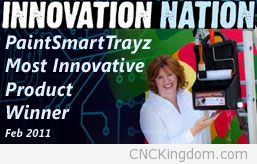Carolyn Keane, Founder of Inventing Daily (USA)
I’ve seen a definite pattern here interviewing inventors on CNCKingdom.com – not only are they passionate about getting their product out in the masses but they generally open businesses that help others do the same, either as an advisor or as another fully fledged business.
Carolyn is the inventor of the PaintSmart-Trayz System, awesome idea that I wished I had before her! She then pivoted to help others with her other business Inventing Daily. Key takeaways from this interview:
- licensing deals aren’t a fast track to fame and fortune
- file a provisional patent first and if your invention has legs, get a full patent within 12 months
- strike while the iron’s hot (an old friend use to tell me this almost daily!)
You can get into contact with Carolyn by visiting her website http://www.InventingDaily.com.
Did you always want to be an entrepreneur and inventor or did things just happen to workout that way? Did you have a patented invention before you became the VP of ISSF?
 As I child, I always liked building things and I have been creating ever since. I received a BS in Design from Syracuse Univ. and am an interior designer so I did a lot of custom work for clients long before coming up with the PaintSmart-Trayz. I was re-building a house that I bought when I came up with the idea.
As I child, I always liked building things and I have been creating ever since. I received a BS in Design from Syracuse Univ. and am an interior designer so I did a lot of custom work for clients long before coming up with the PaintSmart-Trayz. I was re-building a house that I bought when I came up with the idea.
I already had applied for the patent before I became the VP. I am no longer affiliated with the group. We are launching a state wide Florida Inventors Congress to connect with Inventor Congress’ around the country. It will be a not for profit group.
Can you describe what the process was like from initial idea to manufacturing the Paintsmart-Trayz which won numerous awards and honors across the USA? (http://paintsmart-trayz.com)
Coming up with the idea for the PaintSmart-Trayz was the easy part. Within 2 weeks of dreaming it up, I had a handmade prototype and was at the attorneys office talking about patents. From there, I hired a man to make the machine, or so I thought. He never finished the work and I had to sue him to get out of the contract. From there, I found an engineer who did drawings, a company in PA that only makes prototypes and small runs of products. They made my first, second and third prototypes. I took the final ones to the National Hardware Show where I met many buyers and got feedback on changes that should be made.
I was able to meet with a buyer from Home Depot who assured me that if I made the changes and manufactured the product, they would do test marketing. I thought I was on my way to millions. Not so. I made the molds, changed the molds, did a short run of 500 pieces and changed the mold again. By then, the Home Depot buyer was no longer in that position.
PaintSmart-Trayz won a contest for most innovative new product in Canada. After that, I was on QVC and the product was on the DIY channel twice. It received great reviews.
I have been through several licensing deals, none of which got very far, but put me in a position to meet a lot of people in the industry. I realized how hard it was to have a single product and get it into the marketplace.
After your incredible success with your invention, why did you want to pivot and start selling and promoting other people’s inventions? Do you help your fellow inventors on Inventing Daily with patent protection, manufacturing and guiding their inventions to market?
I have been Inventing products for the last 10 years. The idea for InventingDaily.com was born of frustration. It is so hard for an individual to get a product on the market by themselves. So we formed InventingDaily.com.
Collectively, the individual products get more exposure and sales. We also coach new inventors on what to do first, what the process involves and we offer referrals to companies we have worked with to help them along the way.
We have an extensive database of qualified companies that we can refer the inventors to. We try to make the path to success a little easier.

What was the entire patent process like and how different or similar was it in Canada compared to the USA? How long did it take and what hurdles did you have to overcome to get it granted?
 The patent process can be easy or tough, depending on who you use as an attorney. I knew it was too involved for me to do on my own so I hired a patent attorney. The utility patent took 6 years (and a lot of money) to be granted.
The patent process can be easy or tough, depending on who you use as an attorney. I knew it was too involved for me to do on my own so I hired a patent attorney. The utility patent took 6 years (and a lot of money) to be granted.
The 2 design patents I was granted were much easier to get. When you apply in the US, you can get a patent in Canada as well just by filling out easy paperwork.
What are your views on the patent system in general and on the recent change to the American system shifting from first to invent to first to register?
I think the “First to Patent” change will take people a while to get used to it but I think it is good in many ways. The newest changes they are currently talking about are totally different and not helpful to the individual inventors. They are in the middle of talks now.
Knowing what you do now, do you tell inventors to focus their money and attention to be first to market or towards achieving a patent first?
I would say it depends on the item. Some items we have seen probably would not get a patent because they are so similar to other products on the market. You need some sort of patent protection in order to get a licensing deal so the best thing we can suggest is to file a Provisional Application which gives you 12 months to figure out what you will do. In that time, you can have prototypes made, get estimates for manufacturing, talk to companies about securing a license or figure out if you want to move forward with the project.
This is what I did with the latest product I created with a partner. We designed it, filed a Provisional Application, and then it took 3+ years, 4 different engineers, 3 prototypes, 2 licensing deals and now the company that licensed it did another prototype and they are currently making the molds. It is never as fast as we would like.
What do successful products have in common? How much of this success is based off luck over marketing or fads?
I think luck happens because of a lot of hard work and preparation. You have to put yourself out there to create opportunities for luck to find you. I think successful products are ones that solve a problem and are well thought out. Marketing plays a huge part in success.
You have to be found in order to become a success in the retail sense. There will always be fads and if you can catch a ride on a fad, go for it. They never last long but then you go on to the next idea.
Anything else you’d like to add?
I love what I am doing now. There were not very many people to turn to that I could trust when I started my first product. I want to change that for new inventors with education and coaching.
We have some exciting things we are working on that will be launched in the next 6 weeks so stay tuned, there is much more to come from InventingDaily.com. We will let you know as it happens.
Thank you for the opportunity to share some of my experiences. I hope it helps other inventors.
